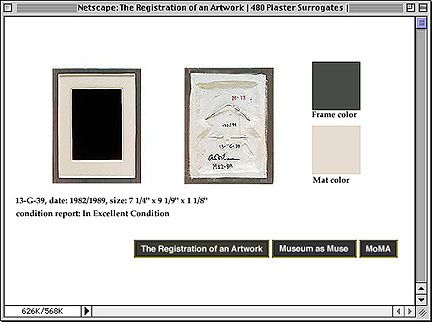The Los Angeles Times
March 25, 1999
Return to:
A Web of Thoughts:
Allan McCollum and Fred Wilson

Sample page from Allan McCollum's website at MoMA, "The Registration of an Artwork." 1999.
By Christopher KnightNow that having an Internet Web site is a standard requirement for any self-respecting art museum, it's to be expected that an exhibition whose subject is the myriad ways artists have responded to museums as cultural, social, economic and political enterprises would include the Web site phenomenon.
"The Museum as Muse: Artists Reflect," a large exhibition that opened recently at New York's Museum of Modern Art, includes two Internet projects commissioned for the show. Allan McCollum's "The Registration of an Artwork" and Fred Wilson's "Road to Victory," both of which can be accessed at www.moma.org, are smart, savvy and illuminating uses of high technology for making art.
"The Registration of an Artwork" turns on a pun in the title, in which the museum term for administrative record-keeping about art objects (registration) is played off the more ephemeral process by which a work of art "registers" in the collective cultural consciousness.
McCollum starts with a work he made in the 1980s: Four Hundred and Eighty Plaster Surrogates, a group of sculptural substitutes for paintings, made in plaster molds. The central rectangle of each pseudo-painting (the place where the image would be) is painted dead-black; the "mat" and "frame" around it are painted in a variety of neutral color combinations.
Pseudo-paintings are perfect for the Internet, where people who log on to museum sites regularly assume they are actually seeing paintings, when, of course, they are gazing at electronic reproductions. McCollum's site lets you chart the surrogates in a variety of ways: how they were made, their physical condition, where they've been exhibited, what configurations they could be installed in, who the studio assistants who actually fabricated them are (Amy Adler, Nicholas Logsdail, etc.), how they've been received critically, and soon.
Along the way, McCollum includes various links to other Web sites. For instance, Adler is now a Los Angeles-based artist who recently had well-received museum and gallery shows. Logsdail, who partly funded the initial fabrication of the surrogates, is the founder of London's Lisson Gallery. Links take you to an online display of Adler's photo-drawings and to Lisson Gallery's Web site.
The links can take you pretty far afield (there's even an online connection to the shipping and storage company that has transported the Four Hundred and Eighty Plaster Surrogates to shows around the world). In McCollum's project, the art museum and the World Wide Web are related creatures: vast and complex networks of relationships, both important and trivial, in which multiple participants -- not just the artist -- confer meaning through action.
[...] For the full text of this article, including more about Fred Wilson, click: here
"Selected Texts"
Return to:
MAIN